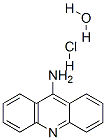9-Acridinamine,hydrochloride, hydrate (1:1:1) cas no:52417-22-8
Synonyms: 9-Acridinamine,monohydrochloride, monohydrate (9CI); 9-Aminoacridine hydrochloride monohydrate
Name9-Acridinamine,hydrochloride, hydrate (1:1:1)
CAS52417-22-8
Synonyms9-Acridinamine,monohydrochloride, monohydrate (9CI); 9-Aminoacridine hydrochloride monohydrate
EINECS(EC#)205-145-5
Molecular FormulaC13H10 N2 . Cl H . H2 O
Molecular Weight248.70812
Appearanceyellow powder
Sensitive Hygroscopic
Globally Harmonized System of Classification adn Labelling of Chemicals(GHS)
Hazardclass6.1
Hazard T:Toxic;
Risk R20;R21;R22
Safety
Safty information about 9-Acridamine, monohydrochloride, monohydrate (CAS NO.52417-22-8) is:
Hazard Codes:  T ;
T ; Xn ;
Xn ; F
F
Risk Statements: 68-23/24/25-40-20/21/22-15-10
R68:Possible risk of irreversible effects.
R23/24/25:Toxic by inhalation, in contact with skin and if swallowed.
R40:Limited evidence of a carcinogenic effect.
R20/21/22:Harmful by inhalation, in contact with skin and if swallowed.
R15:Contact with water liberates extremely flammable gases.
R10:Flammable.
Safety Statements: 22-24/25-45-43-36/37/39-36-7/8
S22:Do not breathe dust.
S24/25:Avoid contact with skin and eyes.
S45:In case of accident or if you feel unwell, seek medical advice immediately (show the label whenever possible.)
S43:In case of fire use ... (there follows the type of fire-fighting equipment to be used.)
S36/37/39:Wear suitable protective clothing, gloves and eye/face protection.
S7/8 :Keep container tightly closed and dry.
RIDADR: 2811
WGK Germany: 3
RTECS: AR6850000
HazardClass: 6.1
PackingGroup: III
SYMPTOMS: Symptoms of exposure to 9-Aminoacridine hydrochloride hydrate include irritation of the gastrointestinal mucosa, nausea and vomiting.


 T ;
T ; Xn ;
Xn ; F
F